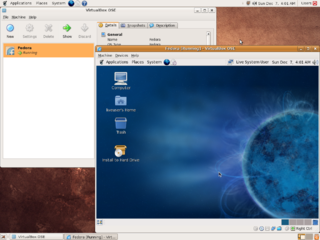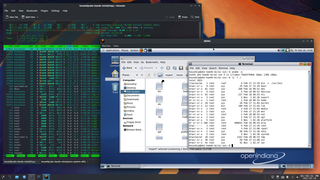
In computing, a virtual machine (VM) is the virtualization or emulation of a computer system. Virtual machines are based on computer architectures and provide the functionality of a physical computer. Their implementations may involve specialized hardware, software, or a combination of the two. Virtual machines differ and are organized by their function, shown here:

VMware LLC is an American cloud computing and virtualization technology company headquartered in Palo Alto, California. VMware was the first commercially successful company to virtualize the x86 architecture.
Platform virtualization software, specifically emulators and hypervisors, are software packages that emulate the whole physical computer machine, often providing multiple virtual machines on one physical platform. The table below compares basic information about platform virtualization hypervisors.
In computing, thin provisioning involves using virtualization technology to give the appearance of having more physical resources than are actually available. If a system always has enough resource to simultaneously support all of the virtualized resources, then it is not thin provisioned. The term thin provisioning is applied to disk layer in this article, but could refer to an allocation scheme for any resource. For example, real memory in a computer is typically thin-provisioned to running tasks with some form of address translation technology doing the virtualization. Each task acts as if it has real memory allocated. The sum of the allocated virtual memory assigned to tasks typically exceeds the total of real memory.

VMware ESXi is an enterprise-class, type-1 hypervisor developed by VMware, a subsidiary of Broadcom, for deploying and serving virtual computers. As a type-1 hypervisor, ESXi is not a software application that is installed on an operating system (OS); instead, it includes and integrates vital OS components, such as a kernel.
VMware VMFS is VMware, Inc.'s clustered file system used by the company's flagship server virtualization suite, vSphere. It was developed to store virtual machine disk images, including snapshots. Multiple servers can read/write the same filesystem simultaneously while individual virtual machine files are locked. VMFS volumes can be logically "grown" by spanning multiple VMFS volumes together.
System Center Virtual Machine Manager (SCVMM) forms part of Microsoft's System Center line of virtual machine management and reporting tools, alongside previously established tools such as System Center Operations Manager and System Center Configuration Manager. SCVMM is designed for management of large numbers of Virtual Servers based on Microsoft Virtual Server and Hyper-V, and was released for enterprise customers in October 2007. A standalone version for small and medium business customers is available.
Infrastructure as a service (IaaS) is a cloud computing service model where a cloud services vendor provides computing resources such as storage, network, servers, and virtualization. This service frees users from maintaining their own data center, but they must install and maintain the operating system and application software. Iaas provides users high-level APIs to control details of underlying network infrastructure such as backup, data partitioning, scaling, security and physical computing resources. Services can be scaled on-demand by the user. According to the Internet Engineering Task Force (IETF), such infrastructure is the most basic cloud-service model. IaaS can be hosted in a public cloud, a private cloud, or a hybrid cloud.
VMDK is a file format that describes containers for virtual hard disk drives to be used in virtual machines like VMware Workstation or VirtualBox.

In computing, virtualization (v12n) is a series of technologies that allows dividing of physical computing resources into a series of virtual machines, operating systems, processes or containers.
Eucalyptus is a paid and open-source computer software for building Amazon Web Services (AWS)-compatible private and hybrid cloud computing environments, originally developed by the company Eucalyptus Systems. Eucalyptus is an acronym for Elastic Utility Computing Architecture for Linking Your Programs To Useful Systems. Eucalyptus enables pooling compute, storage, and network resources that can be dynamically scaled up or down as application workloads change. Mårten Mickos was the CEO of Eucalyptus. In September 2014, Eucalyptus was acquired by Hewlett-Packard and then maintained by DXC Technology. After DXC stopped developing the product in late 2017, AppScale Systems forked the code and started supporting Eucalyptus customers.

VMware vSphere is VMware's cloud computing virtualization platform.
Live migration, also called migration, refers to the process of moving a running virtual machine (VM) or application between different physical machines without disconnecting the client or application. Memory, storage, and network connectivity of the virtual machine are transferred from the original guest machine to the destination. The time between stopping the VM or application on the source and resuming it on destination is called 'downtime'. When the downtime of a VM during live migration is small enough that it is not noticeable by the end user, it is called a 'seamless' live migration.

Universal Storage Platform (USP) was the brand name for an Hitachi Data Systems line of computer data storage disk arrays circa 2004 to 2010.

OpenNebula is an open source cloud computing platform for managing heterogeneous data center, public cloud and edge computing infrastructure resources. OpenNebula manages on-premises and remote virtual infrastructure to build private, public, or hybrid implementations of infrastructure as a service (IaaS) and multi-tenant Kubernetes deployments. The two primary uses of the OpenNebula platform are data center virtualization and cloud deployments based on the KVM hypervisor, LXD/LXC system containers, and AWS Firecracker microVMs. The platform is also capable of offering the cloud infrastructure necessary to operate a cloud on top of existing VMware infrastructure. In early June 2020, OpenNebula announced the release of a new Enterprise Edition for corporate users, along with a Community Edition. OpenNebula CE is free and open-source software, released under the Apache License version 2. OpenNebula CE comes with free access to patch releases containing critical bug fixes but with no access to the regular EE maintenance releases. Upgrades to the latest minor/major version is only available for CE users with non-commercial deployments or with significant open source contributions to the OpenNebula Community. OpenNebula EE is distributed under a closed-source license and requires a commercial Subscription.
VM-aware storage (VAS) is computer data storage designed specifically for managing storage for virtual machines (VMs) within a data center. The goal is to provide storage that is simpler to use with functionality better suited for VMs compared with general-purpose storage. VM-aware storage allows storage to be managed as an integrated part of managing VMs rather than as logical unit numbers (LUNs) or volumes that are separately configured and managed.
Software-defined storage (SDS) is a marketing term for computer data storage software for policy-based provisioning and management of data storage independent of the underlying hardware. Software-defined storage typically includes a form of storage virtualization to separate the storage hardware from the software that manages it. The software enabling a software-defined storage environment may also provide policy management for features such as data deduplication, replication, thin provisioning, snapshots and backup.

Tintri, Inc. is a division of DataDirect Networks based in Santa Clara, California. Tintri provides products designed for businesses cloud computing, virtual machines (VMs), and containers. The core product line is the VMstore, a storage system and software designed to simplify management in data center and cloud environments. After becoming a public company in 2017, within a year it ran out of cash and was acquired in bankruptcy.
Dell PowerEdge VRTX is a computer hardware product line from Dell. It is a mini-blade chassis with built-in storage system. The VRTX comes in two models: a 19" rack version that is 5 rack units high or as a stand-alone tower system.

Dell Technologies PowerFlex, is a commercial software-defined storage product from Dell Technologies that creates a server-based storage area network (SAN) from local server storage using x86 servers. It converts this direct-attached storage into shared block storage that runs over an IP-based network.








